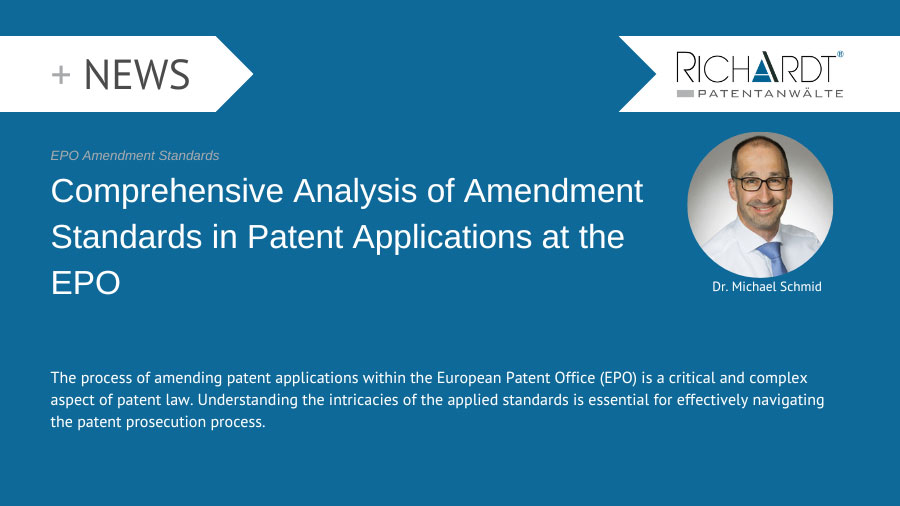Understanding the intricacies of the applied standards is essential for effectively navigating the patent prosecution process.
The EPO’s Gold Standard in Patent Application Amendments
At the heart of the amendment process at the EPO is the gold standard, rooted in the principle outlined in Art. 123(2) EPC. This principle mandates that any amendment to a European patent application or patent must not extend the content beyond what was originally filed. Key aspects of this standard include:
- Non-Extendable Disclosure: The core of this rule is to prevent amendments that would introduce new information not initially disclosed in the original application.
- Skilled Person’s Derivation: Amendments must be such that a skilled person, using common general knowledge, could directly and unambiguously derive them from the application as filed, considering the filing date.

Interpreting "Directly and Unambiguously" with respect to dependent claims
The interpretation of what constitutes "directly and unambiguously" derivable is a significant point of debate. This becomes particularly challenging when amendments involve the detailed description or drawings of patent applications. The situation is somewhat clearer when dealing with features disclosed in dependent claims, but even here, complexities arise:
- Historical EPO Rulings: Decisions like T 727/00 highlight the complexities in interpreting the extendable content of an original filing, especially when dealing with arbitrary selections from feature lists.
- The Flexibility Offered by T 1621/16: In contrast, the October 2019 ruling in T 1621/16 provided a more lenient interpretation, allowing for more flexibility in amendments based on multiple selections from lists of converging alternatives.
The Restrictive T 1137/21 Ruling and Its Implications
The June 2023 ruling of T 1137/21 represents a significant development in the EPO’s approach to amendments. This ruling introduces a new perspective on the permissible combination of features from different claims. It emphasizes the importance of the degree of freedom possible for potential amendments and their alignment with the original invention’s core aspects. Key takeaway:
- Degrees of Freedom: The decision focuses on the number of independent directions in which potential amendments can go. The higher the number of independent directions and the number of possible combinations of features, the more difficult it is to argue that the respective amendments constitute a deliberately formulated part of the invention and in this respect are based on a direct and unambiguous disclosure of an invention.
Consequences of Restrictive EPO Ruling on Amendments
Patents are a right of prohibition and thus a powerful weapon in economic activity, regulating the relationships between the parties involved. It must therefore be ensured that the legislator's reward for prohibiting another party from performing a certain act may only be granted if a corresponding inventive contribution has really been made. This must not be the case, however, if a large number of aspects are randomly claimed in patent applications without ever having consciously played a role in connection with an invention. A prohibition right should therefore only be rewarded if there are aspects that actually constitute a recognizably intended independent invention. In this sense, T 1137/21 will in many cases provide good arguments why amendments made during patent prosecution should be considered inadmissible.
Strategic Drafting of Patent Applications
Given the evolving legal landscape, strategic drafting of patent applications becomes increasingly important. Of course, it's advisable to remain flexible when drafting claims and not to limit oneself to a single implementation variant too early in the process. Alternative features in the dependent claims are often welcome to provide the basis for a sufficiently broad use of generic terms, which might not be possible if only a single embodiment were to be described. Nevertheless, to ensure compliance with EPO standards, patent applicants need to:
- Avoid Over-Complication: Refrain from introducing an excessive number of diverging variants and potential combinations of features that could complicate the amendment process.
- Focus on Essential Features: Clearly articulate the essential features of the invention, ensuring that any future amendments align with the most preferred forms of the invention and appear as a deliberate part of the original disclosure.
Conclusion: Navigating the Complexities of EPO Amendment Standards
Navigating the standards of amendments in patent applications at the EPO demands a thorough understanding of the legal framework and strategic application drafting. Our role as patent law experts is to guide our clients through this complex terrain, ensuring that their inventive contributions are not only protected but are also compliant with the stringent requirements of the EPO.
Talk to us and contact us for further information at:
Phone: +49 (0)611 / 341568-0
Fax: +49 (0)611 / 341568-11
E-mail: Send email to us
PGP-Key
Author: Dr. Michael Schmid
